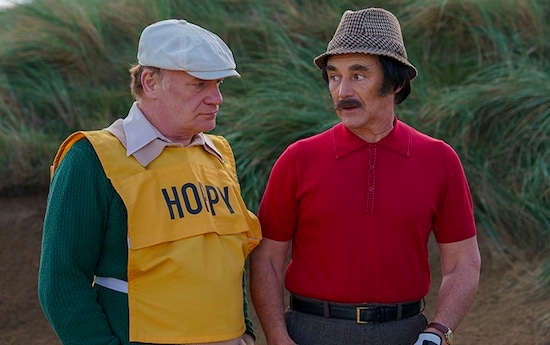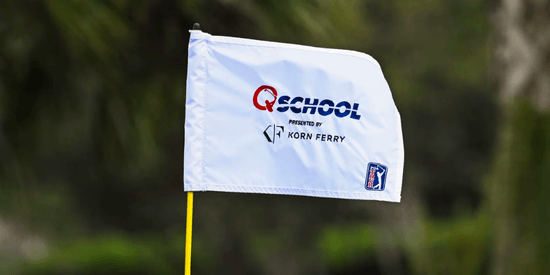OPINION: Golfers shooting 108 in Open qualifiers must be yanked
5/11/2022 | by Pete Wlodkowski of AmateurGolf.com

"The Phantom of The Open" celebrates golf imposter Maurice Flitcroft. It might inspire more shenanigans if authorities don't act.
For 22 years, AmateurGolf.com has been like Switzerland in the golf world. We report on the action, but we stay neutral.
Today, I'm changing everything with the first in a series of opinion pieces. And no, I'm not going to dip my toe into LIV Golf or anything like that. That tragedy is playing out in front of our eyes like a train wreck. But I have plenty of opinions on the state of the game - most of them positive. (Maybe that's why I've never published an opinion piece before -- in general, I love the game's direction.)
What has my "Two Unders" bunched up right now is the continued mockery made of U.S. Open qualifiers by a select few people, as evidenced by yesterday's reporting by Monday Q and several other publications.
It seems that a golfer who finished at the bottom of his fantasy football league was "punished" by being forced to enter a U.S. Open qualifier, where he shot a cool 112. Now, as an amateur, he would have been required to show proof of a handicap index of 1.4 or lower, but he registered as a pro, requiring a simple statement and nothing else.
The "pro" got set to tee off in a qualifier at Oakwood Country Club in Kansas City on Monday, May 9. He almost missed his tee time due to going to the wrong tee. He hit his opening tee shot a whopping 20 yards, right behind a tree. Things got worse from there. And believe it or not, his total was only four shots worse than the next highest score, a 108 posted by an amateur.
So what's the big deal, you might ask? And what can anyone really do about it?
After all, these players didn't really hurt anyone, at least not physically. You could say they were just a couple of guys out having some fun. But serious golfers had to put up with the distraction of being paired with a beginner and help them find their errant shots. Evidently, the pro went through well more than a dozen balls.
Both of these obviously unqualified golfers made a mockery of a serious qualifier. And a new movie coming out in June -- more on that later -- might inspire more people to do the same.
Here is a bit more detail on how things transpired.
For the amateur player, who posted a 108 with two pars, the rules of entry were clear, and it's very obvious -- after a little digging by me -- what he did to bypass them. According to the USGA's information pamphlet for the U.S. Open:
Entries are open to professional golfers, amateur golfers, and applicants for reinstatement. Amateurs and applicants for reinstatement must have an up-to-date Handicap Index® based on ratings for men not exceeding 1.4 under the Rules of Handicapping. A current Handicap ID number (GHIN) issued through an authorized golf club is required and must be submitted on the entry form. The USGA accepts an up-to-date Handicap Index issued from authorized national and regional associations around the world that would be equivalent to a Handicap Index within the prescribed limit for entry into the Championship.
I logged in to the trusty GHIN system to see how a player that posted 108 could be a +.4 handicap (with a low index of +2.3.)
It seems that said player had three remarkable rounds in March, just weeks before the entry deadline of April 13. He posted rounds of 69-69-67 at courses with a rating over 73. Holy cow, this guy really found some magic! In reality, what he found is that the handicap system relies on the integrity of golfers. And while the designers of the system have many protections in place to prohibit a golfer from keeping an artificially high handicap, the same doesn't seem to be true on the "reverse sandbagger" side. You know the guy (or gal). They say they are a single digit but can't break 90.
Even after posting a practice round at Oakwood CC of 100 and then the 108 the next day (which was "adjusted" to 100), the amateur golfer's index is still a plus number.
There are likely thousands of players in Kansas with a verified index of less than three who would have loved the chance to try their luck at a "local" -- many of them with tournament experience. But Mr. 108 got a spot and dragged his playing partners along with him for the ride.
I started with the amateur and not the guy who shot 112 as a "pro" because the USGA application really doesn't say anything about professional golfer criteria. But it should. The golfer entering as a pro should be forced to list something -- anything -- that would show his ability to compete at the national level.
Once the dust settles, the only punishment that either player will receive is a letter from the USGA or local golf association barring them from future competitions -- until they can prove their ability to play "at the national level."
If you've gotten this far, you may be wondering why I think it's a problem. Well, here's the deal. This behavior has been going on for years on both sides of the pond, and a British movie coming out in the USA this June actually celebrates it. The movie, called "The Phantom of The Open" is about, according to Golf Digest:
Maurice Flitcroft—the Great Impersonator who five times attempted to qualify for the Open Championship under various pseudonyms.
And unlike some golf movies, this one might actually get watched by a few people. Which may bring a romanticism (and the movie is actually a love story) to the entire concept of entering a golf tournament with false credentials.
My proposed solutions are not going to be easy to implement. They start with forcing professional entrants to list events they have played (even if that means amateur tournaments for newly-minted pros) along with links to Golf Genius or other leaderboards. Something that would have been hard to check in the past will be easy with the assistance of modern technology. If. you shoot a score these days, it's on your "permanent record" as they say.
On the amateur side, I would require the same thing. It's going to be harder to check, but let's just say that anyone who is playing in the U.S. Open as their first tournament ever has a bigger problem on their hands than shooting 100.
Finally, I would recommend that golf associations and those administering qualifying events put a policy in place that allows them to, after 9 holes, remove from the course anyone that doesn't post a score under 50. This rule could be waived if a player made one "big number" or if the entire field is blowing up due to a hurricane or snowstorm. It happens.
But it would provide them the opportunity to do exactly what the Royal & Ancient did to Mr. Flitcroft, who did this not one, but FIVE times, using pseudonyms and other trickery to bypass the system. Playing in 1983 as a purported Swiss professional named Gerard Hoppy, Flitcroft was pulled off the course by officials after a front nine of 63.
In the movie, Flitcroft is played by an actor with serious chops, three-time Tony Award winner Sir Mark Rylance. I'm looking forward to watching it, if only for lines like the one Flitcroft utters after his 121.
“I don’t feel the score was a fair reflection of my play.”
Watch a trailer for "The Phantom of The Open" below.
Today, I'm changing everything with the first in a series of opinion pieces. And no, I'm not going to dip my toe into LIV Golf or anything like that. That tragedy is playing out in front of our eyes like a train wreck. But I have plenty of opinions on the state of the game - most of them positive. (Maybe that's why I've never published an opinion piece before -- in general, I love the game's direction.)
What has my "Two Unders" bunched up right now is the continued mockery made of U.S. Open qualifiers by a select few people, as evidenced by yesterday's reporting by Monday Q and several other publications.
It seems that a golfer who finished at the bottom of his fantasy football league was "punished" by being forced to enter a U.S. Open qualifier, where he shot a cool 112. Now, as an amateur, he would have been required to show proof of a handicap index of 1.4 or lower, but he registered as a pro, requiring a simple statement and nothing else.
The "pro" got set to tee off in a qualifier at Oakwood Country Club in Kansas City on Monday, May 9. He almost missed his tee time due to going to the wrong tee. He hit his opening tee shot a whopping 20 yards, right behind a tree. Things got worse from there. And believe it or not, his total was only four shots worse than the next highest score, a 108 posted by an amateur.
So what's the big deal, you might ask? And what can anyone really do about it?
After all, these players didn't really hurt anyone, at least not physically. You could say they were just a couple of guys out having some fun. But serious golfers had to put up with the distraction of being paired with a beginner and help them find their errant shots. Evidently, the pro went through well more than a dozen balls.
Both of these obviously unqualified golfers made a mockery of a serious qualifier. And a new movie coming out in June -- more on that later -- might inspire more people to do the same.
Here is a bit more detail on how things transpired.
For the amateur player, who posted a 108 with two pars, the rules of entry were clear, and it's very obvious -- after a little digging by me -- what he did to bypass them. According to the USGA's information pamphlet for the U.S. Open:
Entries are open to professional golfers, amateur golfers, and applicants for reinstatement. Amateurs and applicants for reinstatement must have an up-to-date Handicap Index® based on ratings for men not exceeding 1.4 under the Rules of Handicapping. A current Handicap ID number (GHIN) issued through an authorized golf club is required and must be submitted on the entry form. The USGA accepts an up-to-date Handicap Index issued from authorized national and regional associations around the world that would be equivalent to a Handicap Index within the prescribed limit for entry into the Championship.
I logged in to the trusty GHIN system to see how a player that posted 108 could be a +.4 handicap (with a low index of +2.3.)
It seems that said player had three remarkable rounds in March, just weeks before the entry deadline of April 13. He posted rounds of 69-69-67 at courses with a rating over 73. Holy cow, this guy really found some magic! In reality, what he found is that the handicap system relies on the integrity of golfers. And while the designers of the system have many protections in place to prohibit a golfer from keeping an artificially high handicap, the same doesn't seem to be true on the "reverse sandbagger" side. You know the guy (or gal). They say they are a single digit but can't break 90.
There are likely thousands of players in Kansas with a verified index of less than three who would have loved the chance to try their luck at a "local" -- many of them with tournament experience. But Mr. 108 got a spot and dragged his playing partners along with him for the ride.
I started with the amateur and not the guy who shot 112 as a "pro" because the USGA application really doesn't say anything about professional golfer criteria. But it should. The golfer entering as a pro should be forced to list something -- anything -- that would show his ability to compete at the national level.
Once the dust settles, the only punishment that either player will receive is a letter from the USGA or local golf association barring them from future competitions -- until they can prove their ability to play "at the national level."
If you've gotten this far, you may be wondering why I think it's a problem. Well, here's the deal. This behavior has been going on for years on both sides of the pond, and a British movie coming out in the USA this June actually celebrates it. The movie, called "The Phantom of The Open" is about, according to Golf Digest:
Maurice Flitcroft—the Great Impersonator who five times attempted to qualify for the Open Championship under various pseudonyms.
And unlike some golf movies, this one might actually get watched by a few people. Which may bring a romanticism (and the movie is actually a love story) to the entire concept of entering a golf tournament with false credentials.
My proposed solutions are not going to be easy to implement. They start with forcing professional entrants to list events they have played (even if that means amateur tournaments for newly-minted pros) along with links to Golf Genius or other leaderboards. Something that would have been hard to check in the past will be easy with the assistance of modern technology. If. you shoot a score these days, it's on your "permanent record" as they say.
On the amateur side, I would require the same thing. It's going to be harder to check, but let's just say that anyone who is playing in the U.S. Open as their first tournament ever has a bigger problem on their hands than shooting 100.
Finally, I would recommend that golf associations and those administering qualifying events put a policy in place that allows them to, after 9 holes, remove from the course anyone that doesn't post a score under 50. This rule could be waived if a player made one "big number" or if the entire field is blowing up due to a hurricane or snowstorm. It happens.
But it would provide them the opportunity to do exactly what the Royal & Ancient did to Mr. Flitcroft, who did this not one, but FIVE times, using pseudonyms and other trickery to bypass the system. Playing in 1983 as a purported Swiss professional named Gerard Hoppy, Flitcroft was pulled off the course by officials after a front nine of 63.
In the movie, Flitcroft is played by an actor with serious chops, three-time Tony Award winner Sir Mark Rylance. I'm looking forward to watching it, if only for lines like the one Flitcroft utters after his 121.
“I don’t feel the score was a fair reflection of my play.”
Watch a trailer for "The Phantom of The Open" below.
Most Popular Articles

2025 PGA TOUR Q-School Guide: Sites, Scores, and Who Advanced
Dec 5, 2025Second Stage is complete and Final Stage awaits at Sawgrass — follow every Q-School leaderboard and the players still chasing
2025 LPGA TOUR Q-Series: Final Qualifying Stage FINAL SCORING
Dec 8, 2025Helen Briem earns medalist honors, 31 players headed to the LPGA next year
2025 PGA TOUR Q-School Final Stage: Ewart Leads Five New TOUR Card Winners
Dec 14, 2025A.J. Ewart topped Final Stage at TPC Sawgrass, leading five players who secured PGA TOUR membership for 2026.
Australian Open at Royal Melbourne: Preview, amateur bios, and how to watch
Nov 30, 2025Rory McIlroy headlines one of the championship's top fields in years - at least four amateurs will have their chance at gloryInside Gil Hanse’s Restoration of Baltusrol’s Upper Course: A Return to Tillinghast’s
Dec 11, 2025Renowned architect Gil Hanse reveals how he brought Baltusrol’s Upper Course back to life by honoring A.W. Tillinghast’s originalLoading latest news...
